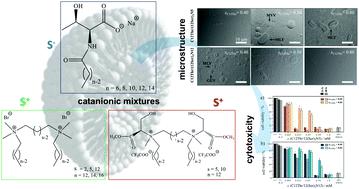当前位置:
X-MOL 学术
›
Soft Matter
›
论文详情
Our official English website, www.x-mol.net, welcomes your
feedback! (Note: you will need to create a separate account there.)
Formation of catanionic vesicles by threonine-derived surfactants and gemini surfactants based on conventional or serine-derived headgroups: designing versatile and cytocompatible nanocarriers
Soft Matter ( IF 2.9 ) Pub Date : 2021-06-28 , DOI: 10.1039/d1sm00766a Isabel S Oliveira 1 , Cidália Pereira 2 , Enrique Borges 2 , M Luísa do Vale 2 , Andreia C Gomes 3 , Eduardo F Marques 1
Soft Matter ( IF 2.9 ) Pub Date : 2021-06-28 , DOI: 10.1039/d1sm00766a Isabel S Oliveira 1 , Cidália Pereira 2 , Enrique Borges 2 , M Luísa do Vale 2 , Andreia C Gomes 3 , Eduardo F Marques 1
Affiliation

|
In this work, we explore the ability of newly synthesized threonine-derived surfactants to form robust, versatile and cytocompatible catanionic vesicles when mixed with gemini surfactants, as potential effective nanocarriers for biomolecules. The threonine surfactants consist of single-tailed amphiphiles with carboxylate headgroups and varying alkyl tail length, CnThr, where n is the (even) number of tail C atoms, varying from 8 to 16. After an initial characterization of the micellization behavior of the neat CnThr surfactants (at pH = 7 and 12), the dodecyl derivative, C12Thr, was selected as the optimal surfactant to investigate regions of formation of spontaneous catanionic vesicles. Phase behavior studies and microstructural characterization of mixtures involving both conventional bis-quat n–s–n gemini (where n and s are the tail and spacer number of C atoms) and biocompatible serine-derived gemini surfactants were carried out. Light and electron microscopy, dynamic light scattering and zeta potential measurements show spontaneous vesicles indeed form and exhibit versatile features in terms of average size, morphology, polydispersity, surface charge and pH. The toxicological profile of the neat surfactants and C12Thr/gemini vesicles based on MTT assays with a L929 cell line was also evaluated, showing good levels of in vitro cytocompatibility. Overall, the assortment of developed catanionic vesicles offers very attractive physicochemical and biological features to be explored for delivery purposes.
中文翻译:

基于常规或丝氨酸衍生头基的苏氨酸衍生表面活性剂和双子表面活性剂形成阳离子囊泡:设计多功能和细胞相容性纳米载体
在这项工作中,我们探索了新合成的苏氨酸衍生表面活性剂与双子表面活性剂混合时形成强大、通用和细胞相容性的阳离子囊泡的能力,作为生物分子的潜在有效纳米载体。苏氨酸表面活性剂由具有羧酸盐头基团和不同烷基尾长 C n Thr的单尾两亲物组成,其中n是尾 C 原子的(偶数)数,从 8 到 16 不等。整洁的 C nThr 表面活性剂(在 pH = 7 和 12 下),十二烷基衍生物,C12Thr,被选为最佳表面活性剂,以研究自发阳离子囊泡的形成区域。涉及传统双季铵盐n-s-n双子座(其中n和s是 C 原子的尾部和间隔数),并进行了生物相容性丝氨酸衍生的双子表面活性剂。光学和电子显微镜、动态光散射和 zeta 电位测量表明自发囊泡确实形成并在平均大小、形态、多分散性、表面电荷和 pH 方面表现出多种特征。还评估了基于 L929 细胞系的 MTT 测定的纯表面活性剂和 C12Thr/gemini 囊泡的毒理学特征,显示出良好的体外细胞相容性水平。总体而言,各种已开发的阳离子囊泡提供了非常有吸引力的物理化学和生物学特征,可用于递送目的。
更新日期:2021-07-14
中文翻译:

基于常规或丝氨酸衍生头基的苏氨酸衍生表面活性剂和双子表面活性剂形成阳离子囊泡:设计多功能和细胞相容性纳米载体
在这项工作中,我们探索了新合成的苏氨酸衍生表面活性剂与双子表面活性剂混合时形成强大、通用和细胞相容性的阳离子囊泡的能力,作为生物分子的潜在有效纳米载体。苏氨酸表面活性剂由具有羧酸盐头基团和不同烷基尾长 C n Thr的单尾两亲物组成,其中n是尾 C 原子的(偶数)数,从 8 到 16 不等。整洁的 C nThr 表面活性剂(在 pH = 7 和 12 下),十二烷基衍生物,C12Thr,被选为最佳表面活性剂,以研究自发阳离子囊泡的形成区域。涉及传统双季铵盐n-s-n双子座(其中n和s是 C 原子的尾部和间隔数),并进行了生物相容性丝氨酸衍生的双子表面活性剂。光学和电子显微镜、动态光散射和 zeta 电位测量表明自发囊泡确实形成并在平均大小、形态、多分散性、表面电荷和 pH 方面表现出多种特征。还评估了基于 L929 细胞系的 MTT 测定的纯表面活性剂和 C12Thr/gemini 囊泡的毒理学特征,显示出良好的体外细胞相容性水平。总体而言,各种已开发的阳离子囊泡提供了非常有吸引力的物理化学和生物学特征,可用于递送目的。











































 京公网安备 11010802027423号
京公网安备 11010802027423号